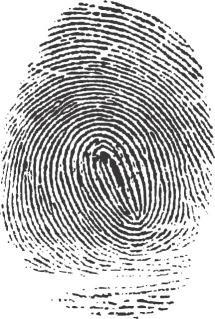
Back بصمة إصبع Arabic Buelga dactilar AST Barmaq izləri Azerbaijani আঙুলের ছাপ Bengali/Bangla Otisak prsta BS Empremta digital Catalan Otisk prstu Czech Fingeraftryk Danish Fingerabdruck German Αποτύπωμα Greek

| Part of a series on |
| Forensic science |
|---|
 |
A fingerprint is an impression left by the friction ridges of a human finger. The recovery of partial fingerprints from a crime scene is an important method of forensic science. Moisture and grease on a finger result in fingerprints on surfaces such as glass or metal. Deliberate impressions of entire fingerprints can be obtained by ink or other substances transferred from the peaks of friction ridges on the skin to a smooth surface such as paper. Fingerprint records normally contain impressions from the pad on the last joint of fingers and thumbs, though fingerprint cards also typically record portions of lower joint areas of the fingers.
Human fingerprints are detailed, unique, difficult to alter, and durable over the life of an individual, making them suitable as long-term markers of human identity.[citation needed] They may be employed by police or other authorities to identify individuals who wish to conceal their identity, or to identify people who are incapacitated or deceased and thus unable to identify themselves, as in the aftermath of a natural disaster.
Their use as evidence has been challenged by academics, judges and the media. There are no uniform standards for point-counting methods, and academics have argued that the error rate in matching fingerprints has not been adequately studied and that fingerprint evidence has no secure statistical foundation.[1] Research has been conducted into whether experts can objectively focus on feature information in fingerprints without being misled by extraneous information, such as context.[2]
- ^ Paul Roberts (2017). Expert Evidence and Scientific Proof in Criminal Trials. Routledge. ISBN 978-1351567398.
- ^ Dror, I.E., Charlton, D. and Péron, A.E. (2006) "Contextual information renders experts vulnerable to making erroneous identifications Archived July 9, 2019, at the Wayback Machine", Forensic Science International, Vol. 156, Iss. 1, pp. 74–78.